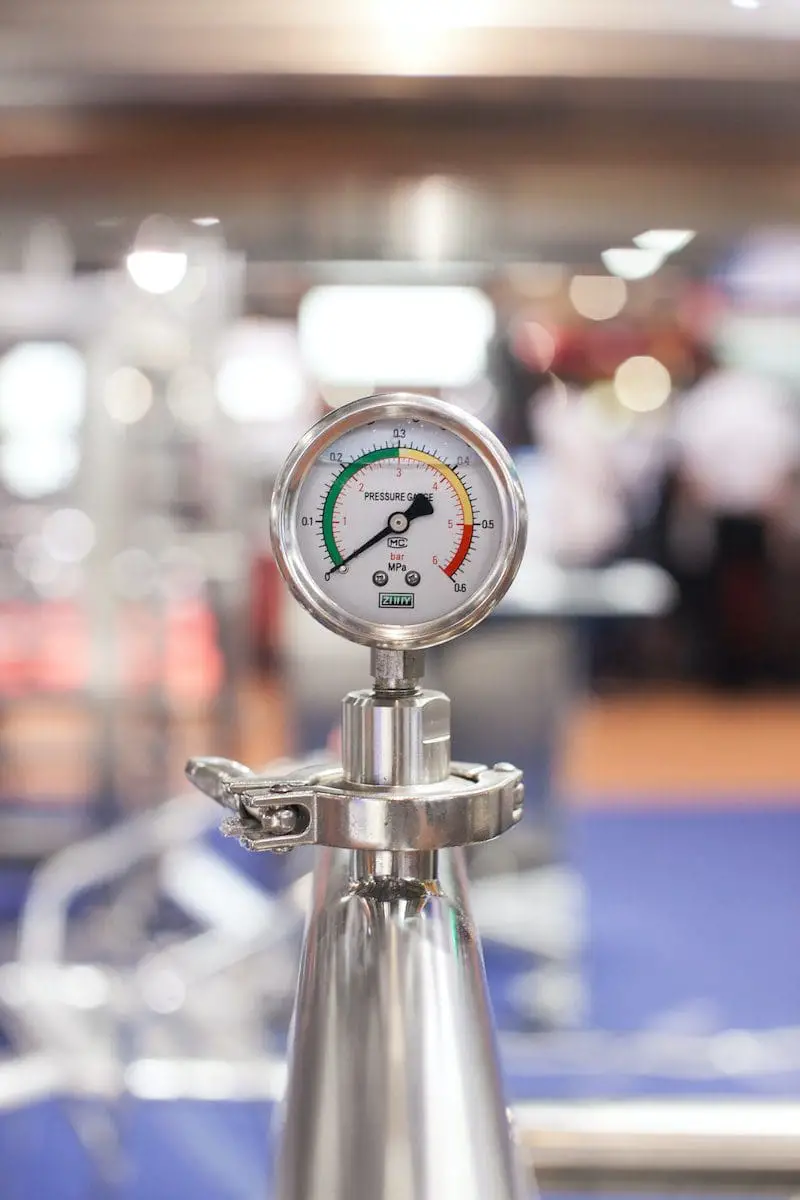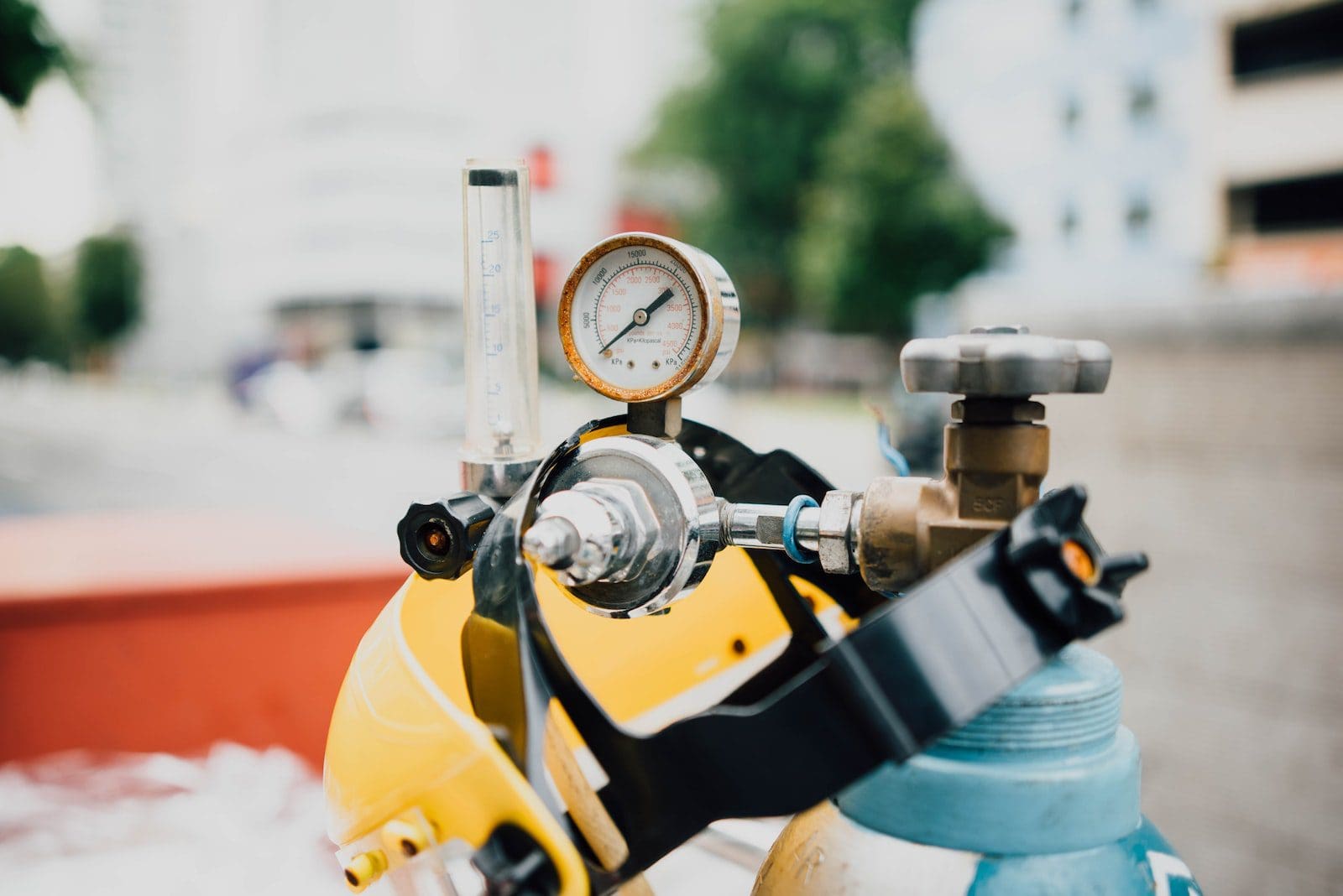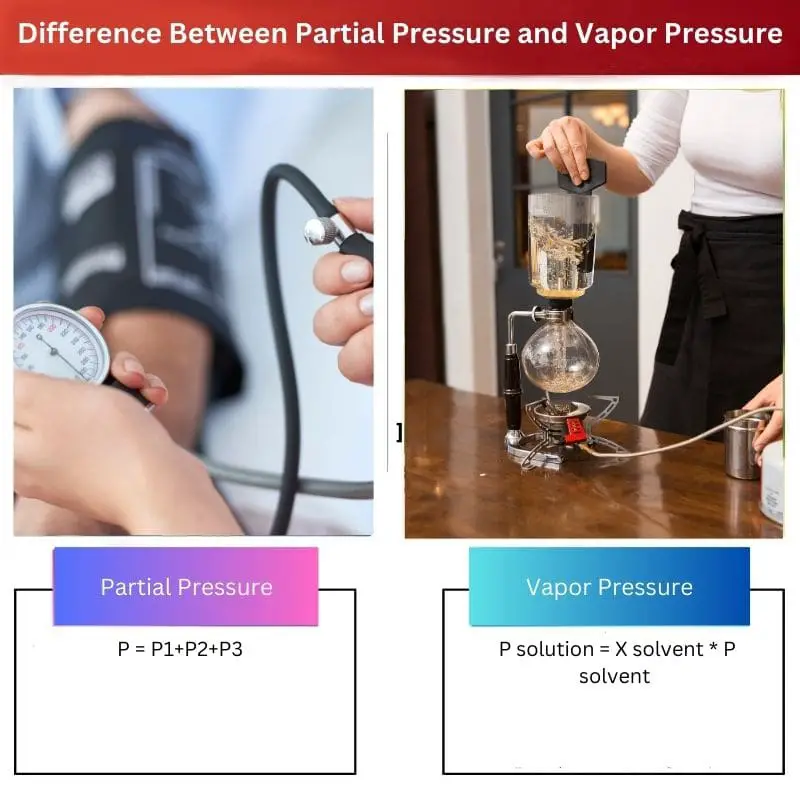Pressure is used to apply some force in order to move something forward. It is used in both physics and chemistry as well. There are different types of pressures, and each has its own definition, advantages, disadvantages, and unique features.
Both Partial Pressure and Vapor Pressure are used in science and are common in all the curriculums across the countries.
Key Takeaways
- Partial pressure measures individual gas component pressure within a mixture, while vapor pressure measures the pressure exerted by a liquid’s vapor in equilibrium with its condensed phase.
- The concept of partial pressure is based on Dalton’s Law of partial pressures, whereas vapor pressure is related to the boiling point of a liquid and varies with temperature.
- Partial pressure applies to gas and liquid mixtures, while vapor pressure is specific to liquids in equilibrium with their vapor phase.
Partial Pressure vs Vapor Pressure
Partial pressure refers to the pressure exerted by one gas in a mixture of gases. Vapour pressure refers to the pressure exerted by the vapour of a liquid in equilibrium with its own liquid state. Partial pressure is a property of a gas mixture, while vapour pressure is a property of a liquid.

Partial pressure is used to deal with pressure and gases. We can even find partial pressure for all the elements in chemistry. Sometimes we can’t really call it partial pressure.
It depends upon the type of molar ratios of the gas container we use. The formula for Partial Pressure is P = P1+P2+P3. The pressure will increase depending on the problem we deal with.
We can simply explain the concept of vapour pressure by boiling water. It will be very helpful to understand the concept in a fast and easier manner.
When we boil the water at higher altitudes, the vapour pressure used to be low there so that the water boils faster and reaches 100 degrees faster. The formula for Vapor Pressure is P solution = X solvent * P solvent.
Comparison Table
| Parameters of Comparison | Partial Pressure | Vapor Pressure |
|---|---|---|
| Formula | P = P1+P2+P3 | P solution = X solvent * P solvent |
| Law | Dalton’s Law | Raoult’s Law |
| Phase | Solid and Liquid | Gas |
| Calculation | Mole Fraction of the Solute | Mole Fraction of the Gas |
| Dependency | Independent | Dependent |
What is Partial Pressure?
In simple words, we can define partial pressure as a container filled with many gases. Each gas is used to exert pressure. The container which contains any one of the gas-filled insides is called partial pressure.
It has a separate law called Dalton’s Law of Partial Pressure. It is used in both chemistry and physics topics. It comes under the category of different types of pressures.
It is mainly used to measure the thermodynamic activity of the molecules of the gas. The symbol used for partial pressure is P or p. The symbol p is used as a subscript to identify pressure. Its features are also used in biology.
It is very important as it helps us to predict the movement of gas molecules. Because gases are used to pressure in two ends and the regions connected.
The partial pressure in liquid can be defined as when the gas would be in an equilibrium position in contact with the liquid. We can increase the partial pressure by simply decreasing its volume. The reactants contain two moles of gases so that the pressure of the reactant will be squared.

What is Vapor Pressure?
When we place a liquid in a vessel, it will get heated, and the molecules will be seen and move in different directions at high speed. The reason for this is the kinetic energy possessed in that liquid.
On the other hand, the molecules of the liquid will rise and it will occupy the surfaces of the liquid. This process is simply called Evaporation. The molecules that pop up on the surface of the liquid are called Vapors.
Vapour Pressure can sometimes be called Vapor Equilibrium Pressure. There are many characteristics of vapour pressure. Temperature acts as the main aspect that affects vapour pressure.
When we raise the temperature, the vapour pressure will also rise. The evaporation process will depend on two following factors as Nature of the liquid and the Effect of Temperature. It contains Raoult’s Law of Expression.
When we have the highest boiling point, we will be able to attain the lowest vapour pressure. It is related to evaporation. It is again used in both chemistry and physics.
Diethyl Ether is the highest vapour pressure in Chemistry. Molecules containing the strongest intermolecular forces are considered the lowest vapour pressure in Chemistry.

Main Differences Between Partial Pressure and Vapor Pressure
- Partial Pressure uses Dalton’s law to explain, while Vapor Pressure uses Raoult’s law to explain.
- Partial Pressure contains dimensionless values, while vapour pressure is used to express it in Pascal.
- When we apply pressure on the mixture of gases at the same time, we call it partial pressure. On the other hand, if pressure is applied to the liquid vapour, we call it vapour pressure.
- Partial Pressure is used to exert pressure on individual gases with different gases and also at different temperatures. In contrast, vapour pressure is used to exert condensed gas when the temperature gets cooled.
- There is a very minute difference in their symbol. We use p to indicate partial pressure. On the other hand, we use p* to indicate vapour pressure.

- https://ceramics.onlinelibrary.wiley.com/doi/abs/10.1111/j.1151-2916.1984.tb19701.x
- https://www.sciencedirect.com/science/article/pii/0040603177850193

The comprehensive explanation of the concepts of partial pressure and vapor pressure, along with the detailed comparison table, provides readers with valuable insights into these fundamental scientific principles. The influence of temperature on vapor pressure dynamics is particularly intriguing.
The detailed explanation of vapor pressure and its correlation with temperature and evaporation process provides a comprehensive understanding of this scientific concept. The insights into the relationship between temperature and vapor pressure dynamics are particularly enlightening.
The clear delineation of vapor pressure characteristics and the factors influencing its behavior enriches the comprehension of this concept, especially in the context of scientific analysis.
The explanation of the nature and temperature-based factors influencing vapor pressure contributes to a deeper understanding of this complex scientific concept. The mention of Raoult’s Law enhances the discussion on vapor pressure dynamics.
Understanding the concept of partial pressure and its application in measuring the thermodynamic activity of gas molecules is vital for scientific analysis. The explanation of partial pressure in liquids and its influence on pressure variation adds depth to the discussion on this topic.
The detailed explanation of partial pressure as it relates to the individual pressure of gas components within a mixture is highly informative. Likewise, the insights into the characteristics and factors affecting vapor pressure provide a comprehensive understanding of these scientific concepts.
The influence of temperature on vapor pressure and its connection to the evaporation process is well-delineated, offering readers a clear understanding of this important scientific principle.
The comparison between partial pressure and vapor pressure provides valuable insights into their distinct properties and applications. Understanding the calculations and laws associated with each type of pressure is essential for scientific analysis.
The significance of vapor pressure and its correlation with the nature of the liquid and temperature changes is clearly outlined. This contributes to a deeper understanding of the concept.
Understanding partial and vapor pressure is crucial in both physics and chemistry, especially when dealing with gases. The concept of partial pressure is based on Dalton’s Law of partial pressures and is used to measure the thermodynamic activity of gas molecules. The pressure of a mixture of gases, on the other hand, is measured using the concept of vapor pressure. Both concepts have unique characteristics and equations that make them essential in scientific methodologies.
The detailed explanation of the relationship between vapor pressure and temperature is intriguing and provides a comprehensive understanding of the concept.
A well-explained overview of partial pressure and vapor pressure with respect to their impact on gas and liquid mixtures.
The elucidation of the relationship between partial pressure and gas mixtures is essential for understanding the dynamics of pressure variations in scientific analysis. Similarly, the detailed insights into the factors influencing vapor pressure and its connection to evaporation contribute to a comprehensive understanding of this concept.
The impact of temperature on the dynamics of vapor pressure, as well as its connection to the evaporation process, is clearly outlined, providing readers with a deep understanding of this scientific principle.
The explanation of partial pressure and its relationship to the thermodynamic activity of gas molecules, along with the insights into the characteristics and factors affecting vapor pressure, adds depth to the comprehension of these scientific concepts.
Understanding the concepts of partial pressure and vapor pressure is crucial in scientific analysis, especially when examining the behavior of gases and liquids. The detailed comparison between partial and vapor pressure provides valuable insights into their distinct properties and influences on scientific methodologies.
The detailed insights into the nature and temperature-based factors influencing vapor pressure enrich the understanding of this complex scientific concept. The elucidation of Raoult’s Law adds depth to the discussion on vapor pressure dynamics.
The comprehensive explanation of the laws and phase differences between partial and vapor pressure enhances the comprehension of these scientific concepts, particularly in the context of the impact on gas and liquid mixtures.
The detailed overview of partial pressure and its application in measuring the pressure of gas mixtures is highly informative. Likewise, the comprehensive explanation of vapor pressure characteristics and its correlation with temperature and liquid nature enriches the understanding of these scientific concepts.
The overview of the formulas and laws governing partial and vapor pressure enhances the comprehension of their distinct applications in scientific analysis. The detailed explanations and comparisons between the two types of pressure aid in establishing a solid foundation for further study in this area.
The detailed comparison table and explanations regarding the dependency and phase differences of partial and vapor pressure contribute to a comprehensive understanding of these fundamental scientific principles.
The explanation of the factors influencing vapor pressure and its relationship with temperature and liquid nature provides valuable insights into the complexities of these scientific concepts.